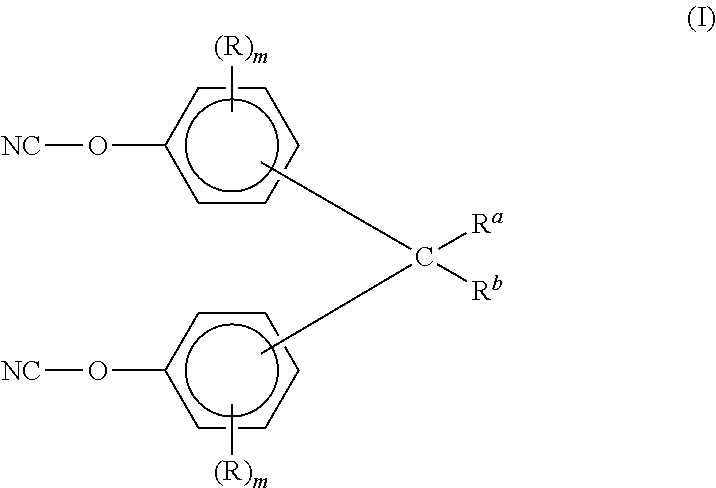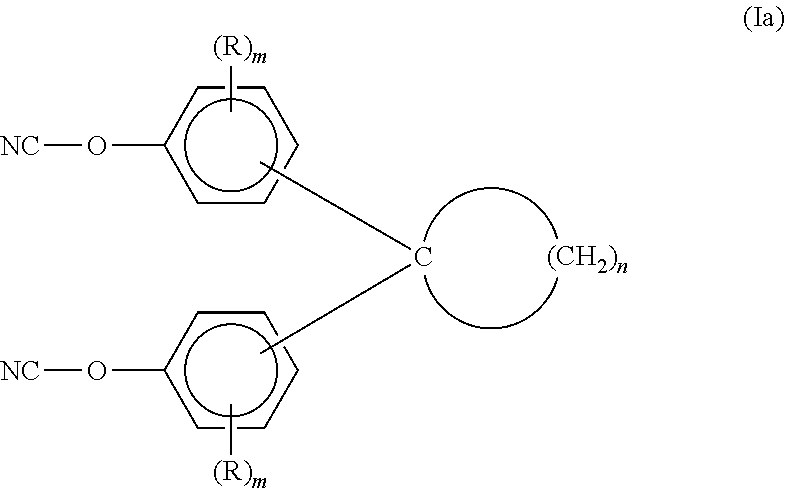Aromatic dicyanate compounds with high aliphatic carbon content
a technology of aromatic dicyanate and high aliphatic carbon content, which is applied in the field of aromatic dicyanate compounds to achieve the effect of improving the dielectric properties of aromatic cyanate resins
- Summary
- Abstract
- Description
- Claims
- Application Information
AI Technical Summary
Benefits of technology
Problems solved by technology
Method used
Image
Examples
example 1
Synthesis of 1,1-Bis(4-cyanatophenyl)cyclododecane
[0103]A 250 milliliter, three neck, glass, round bottom reactor was charged with 1,1-bis(4-hydroxyphenyl)cyclododecane (17.63 grams, 0.10 hydroxyl equivalent) and acetone (125 milliliters, 7.09 milliliter per gram of bisphenol). The reactor was additionally equipped with a condenser (maintained at 0° C.), a thermometer, an overhead nitrogen inlet (1 LPM N2 used), and magnetic stirring. Stirring commenced to give a solution at 21.5° C. Cyanogen bromide (11.12 grams, 0.105 mole, 1.05:1 cyanogen bromide:hydroxyl equivalent ratio) was added to the solution and immediately dissolved therein. A dry ice-acetone bath for cooling was placed under the reactor followed cooling and equilibration of the stirred solution at −5° C. Triethylamine (10.17 grams, 0.1005 mole, 1.005 triethylamine:hydroxyl equivalent ratio) was added using a syringe in aliquots that maintained the reaction temperature at −5 to 0° C. The total addition time for the trieth...
example 2
Synthesis of the Homopolytriazine of the 1,1-Bis(4-cyanatophenyl)cyclododecane
[0107]Differential scanning calorimetry (DSC) analysis of a portion (9.8 milligrams) of 1,1-bis(4-cyanatophenyl)cyclododecane from Example 1 above was completed using a rate of heating of 7° C. per minute from 25° C. to 400° C. under a stream of nitrogen flowing at 35 cubic centimeters per minute. A single melt endotherm was detected with a 120.8° C. onset, a 129.6° C. midpoint, and a 136.0° C. end, accompanied by an enthalpy of 4.5 joules per gram. A single exotherm attributed to cyclotrimerization was detected with a 194.8° C. onset, a 289.4° C. midpoint, and a 340.3° C. end, accompanied by an enthalpy of 562.3 joules per gram. A second scanning of the resultant homopolytriazine revealed a weak transition at 202.1° C. which may be a glass transition temperature. The homopolytriazine recovered from the DSC analysis was a transparent, light amber colored, rigid solid.
example 3
Synthesis and Recrystallization to Produce High Purity 1,1-Bis(4-cyanatophenyl)cyclododecane
[0108]The synthesis of 1,1-bis(4-cyanatophenyl)cyclododecane of Example 1 was repeated, but with a 2-fold increase in scale. The 38.86 grams of recovered product assayed 0.69 area percent unreacted 1,1-bis(4-hydroxyphenyl)cyclododecane, 3.91 area % monocyanate, and 95.40 area % dicyanate by HPLC analysis. Recrystallization was performed by forming a solution in boiling acetone (50 milliliters), then holding for 24 hours at 23° C. The acetone solution was removed from the crystalline product via decantation. HPLC analysis of a portion of the damp crystalline product revealed the presence of no detectable unreacted 1,1-bis(4-hydroxyphenyl)cyclododecane, 1.02 area % monocyanate, and 98.98 area % dicyanate. A second recrystallization of the damp crystalline product from acetone (40 milliliters) followed by drying in the vacuum oven at 50° C. for 48 hours provided 20.12 grams of brilliant white pr...
PUM
| Property | Measurement | Unit |
|---|---|---|
| Temperature | aaaaa | aaaaa |
| Temperature | aaaaa | aaaaa |
Abstract
Description
Claims
Application Information
 Login to View More
Login to View More - R&D
- Intellectual Property
- Life Sciences
- Materials
- Tech Scout
- Unparalleled Data Quality
- Higher Quality Content
- 60% Fewer Hallucinations
Browse by: Latest US Patents, China's latest patents, Technical Efficacy Thesaurus, Application Domain, Technology Topic, Popular Technical Reports.
© 2025 PatSnap. All rights reserved.Legal|Privacy policy|Modern Slavery Act Transparency Statement|Sitemap|About US| Contact US: help@patsnap.com



